I was happy to get this stately fellow against the skyline but it took a while before it happened.
- I don’t believe I’ve ever before posted mammals to Feathered Photography on consecutive days (yesterday I posted a coyote) and it wasn’t planned this time. Things just turned out that way.
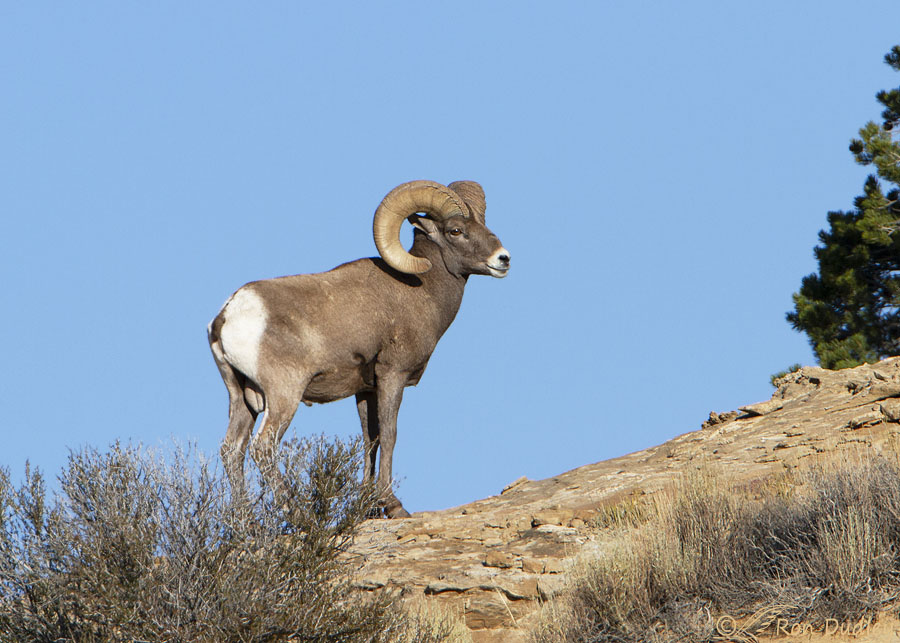
I photographed this Desert Bighorn ram during a camping trip to the canyonlands of southern Utah in the fall of 2009. I wasn’t quite as close as I’d like but he was wary and nervous anyway. This head angle doesn’t do justice to the size and breadth of his horns but at least it provided a catch light in his eye.
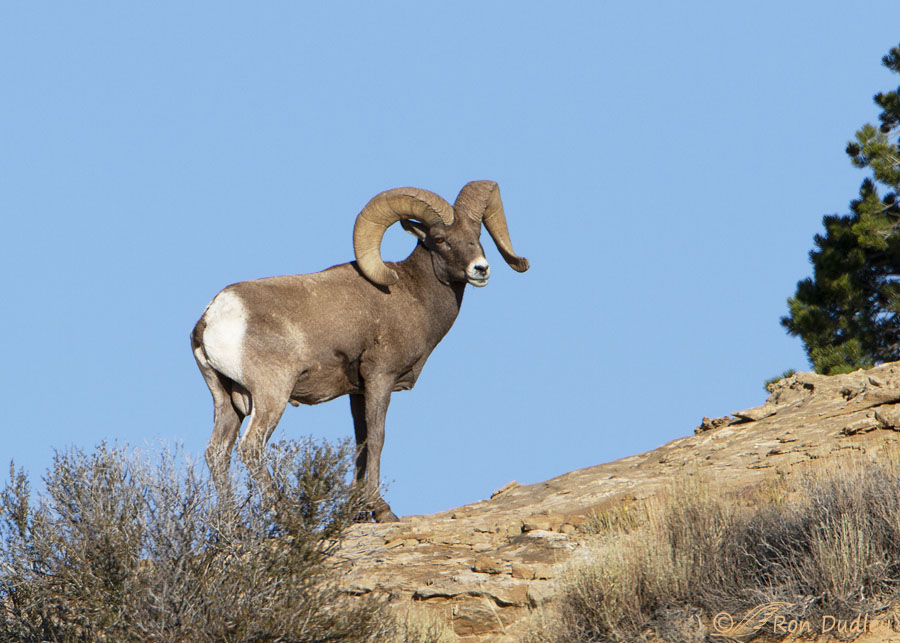
When he turned his head more toward me we lost the catch light but this pose allows us to better appreciate his massive horns.
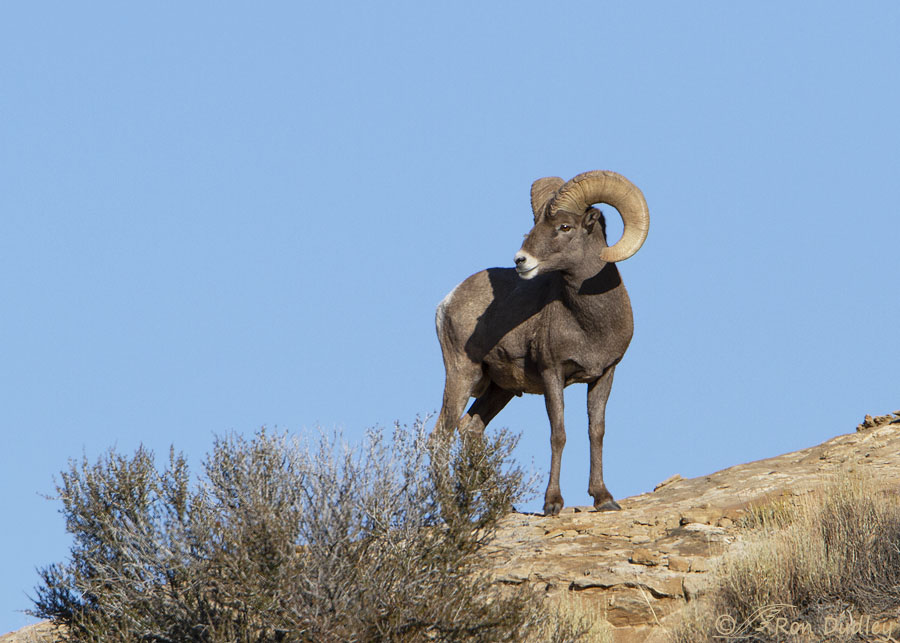
And soon he even allowed us a better look at his left horn curl.
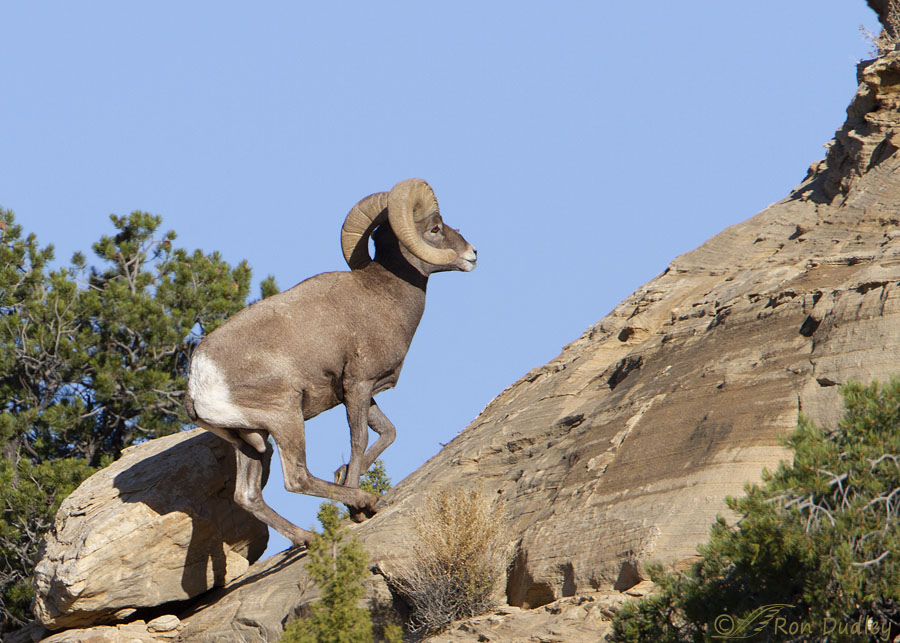
But not long after the previous photo was taken he skedaddled and he didn’t take a particularly easy route. He scampered up a steep incline and…
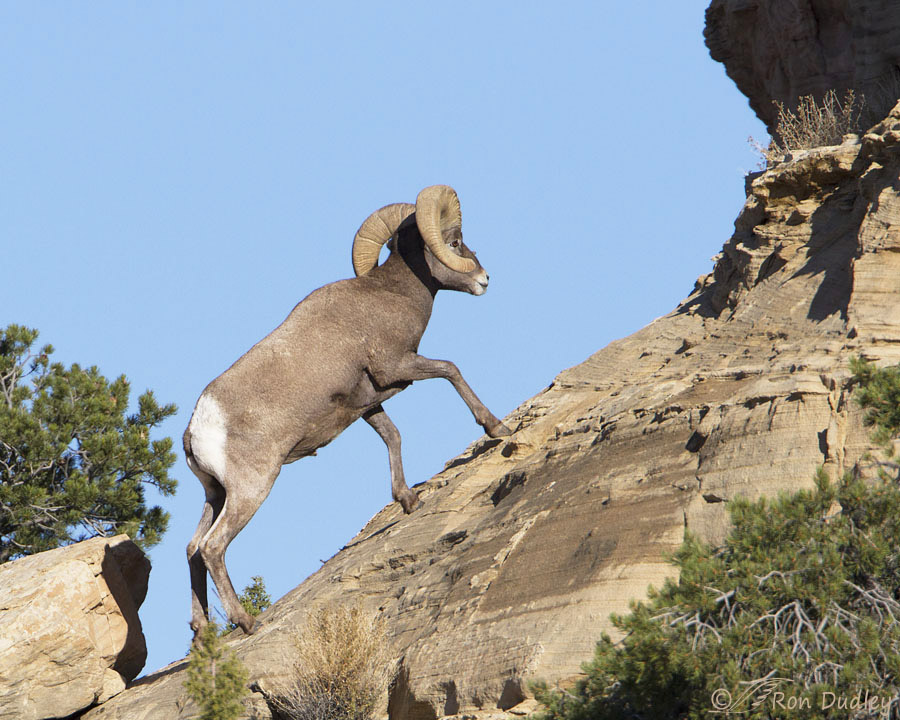
disappeared around the far side of the slope.
Bighorn rams can be aged by counting the growth rings or annuli on their horns. Here we can distinctly see three of them on the ram’s left horn but determining age accurately is just a little more complicated than it might first appear. If you’re interested in seeing how it’s done please follow this link.
Ron
Notes:
- One of the most common natural history errors I see people make is confusing antlers and horns. They have distinct differences and I always cringe a little inside when I see folks use the wrong terminology for one or the other. Some years ago I published a post on the subject that can be seen here if you have the interest.
- Here’s the image techs for the photos in today’s post: 1/1250-2000, f/8, ISO 400, Canon 7D, Canon EF 500mm f/4L IS II USM + EF 1.4 III Extender.


I have heard that the tips of the horns are broken off purposely because otherwise they interfere with their vision.
Buff, I read somewhere that those tips are broken off accidentally during normal activities when they’re young and the growing horns are small and vulnerable to being broken. Don’t know for sure what’s really true.
Ron, it is hard to find a more impressive word than “impressive’ for this animal. Their mating ritual must be dangerous with those big horns clashing against each other. I wonder how many wounded/dead animals arise from it. Thank you for the great photos and narrative.
“Impressive” seems accurate to me too, Alice. Thank you.
Impressive, indeed. Both the Ram and the photos. Referring to the aging link, this one looks to be about 7 years old. How many horror movies have had a Ram as the devil? I wonder if you subconscious mind picked this animal for today, it being Halloween
It would have to have been buried way down deep in my subconscious, Lyle. I didn’t even remember it was Halloween until much later this morning. Now I’m depressed…
Thank you, as always, for continuing my education.
Those horns look HEAVY. Spectacular, but heavy.
They ARE heavy, EC. See my reply to Kathy’s comment below.
Thanks for another series of wonderful images!
There’s a city park just a little west of the Hoover Dam where bighorns hang out, often letting people get to within about 20-ish feet of them. It’s not the same impressive topography as this fine fellow treated you to, but it’s also cool to sit on one of the benches while they lounge on the grass taking their afternoon naps. They’re very cool critters (but yeah, I’m easy with critters)!
Desert Bighorns can be pretty tame in places like Arches NP also, Laura. But this guy was pretty shy.
Oh what beautiful pictures. Thank you for sharing. Never seen a Desert Big Horn Sheep. We have Big Horn Sheep in our mountains, but I have never seen one. They are the Shell side of the Big Horn Mountains. We also have then around the Lovell area. I think they are smaller than the Desert Ones. You are so lucky to get some nice pictures of this one.
I’m glad to know you like them. Thanks, Trudy.
Nice! Last time I saw one of these was the last millenium, on a peak in southern Utah near the Nevada border .. thanks for the beautiful shots with great light.
“a peak in southern Utah near the Nevada border”
Sounds like you might have been in the Goshute Mtns, Martha. At first I thought it might have been Great Basin NP but that isn’t quite in “southern” Utah.
Ron, you’re right, I was in the Goshute. . a lot of very strange – very strange – country in there.
Thus is as nice animal at the top of my “want to see” list. Great series.
Thanks, Arwen.
Fantastic series Ron!
Charlotte
Thanks, Charlotte.
Very educational post for an Easterner! Excellent shots, beautiful settings, that would be a life mammal for me!
Thanks for sharing!
Better put bighorns on your bucket list, Dick!
Wonderful shots. The amaze me how they can scale a hill you and I wouldn’t dare.
Thank you, Jean.
Gorgeous specimen! Nice that he cooperated for a bit.
Nice that he cooperated for a bit.  Don’t know if that’s some sort of injury on his right side or just the way he is? Yes, folks think horns/antlers are interchangeable terms when the aren’t….. Chinook of sorts “trying” to melt things down.
Don’t know if that’s some sort of injury on his right side or just the way he is? Yes, folks think horns/antlers are interchangeable terms when the aren’t….. Chinook of sorts “trying” to melt things down.
Looks to me like he might have several scars on his right side, Judy. Not surprising considering the violence of their fights.
Wow Ron, no feathers on that gorgeous animal, but what remarkably good photos. You said you would have liked to have been closer, but I can’t imagine the photos being any better. Perfect sky and landscape and even a catch-eye in most of the shots. Could not ask for much more than that. The funniest thing about your post is “he skedaddled.” That’s a word I don’t think I have heard since the Roy Rogers, Gabby Hayes, western movie days of my youth. Bet you could have one of those on the street interviews with young people at a college campus and ask them what that word means and you would probably just get blank stares.
I like those old-timer terms, Everett. Thanks for jogging my memory, yes I believe “skedaddle” was often used in old westerns, including some starring Roy Rogers.
Quite an impressive set of horns! Made me curious as to the weight of that set. As usual your references led me on a little ‘wild goose chase’ after I read your post and curiosity took over. The prong horns then led me to it’s African cousins. Then I ventured onto goats, (I had a pet goat when first moved to WI) and their horns, So quite a bit of learning this a.m. Three inches of snow over-nite and still snowing…not ready for this change but then perhaps we will have a seventy degree Thanksgiving. Thanks for the lesson this morning!
Three inches of snow over-nite and still snowing…not ready for this change but then perhaps we will have a seventy degree Thanksgiving. Thanks for the lesson this morning!
“Made me curious as to the weight of that set”
Kathy, your wondering made me wonder too so I checked. National Geographic says the horns of bighorns can weigh as much as 30 lbs, more than the combined weight of all of the bones in their body.
Now that is impressive!
I’m always so impressed with how deft Bighorn Sheep are on rocky hillsides. This is a magnificent specimen! I have absolutely no qualms in seeing mammals two days in a row — actually, in seeing ANYTHING you photograph two days in a row.
Snap. Too many Ron photos (of anything) would be barely enough.
Thanks Marty but I do hope to get back to birds tomorrow.
I agree with Steve that, in my uneducated opinion, this is an impressive photo. Thanks for sharing Ron.
Thank you, Brad.
Really enjoyed this morning’s lesson and images.
Nicely done and what a beautiful animal.
We’re off to Bosque del Apache for the first time, hoping to see a roadrunner and more.
Glad you enjoyed it, Dave. Have fun at Bosque. I’ve never been there but I have friends and friends of friends who go there often.
Impressive is all I can say, just impressive.
Agreed. These Desert Bighorn rams have even more impressive horns than those of Rocky Mountain Bighorns.